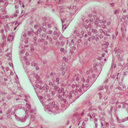The role of apigenin in an experimental model of acute pancreatitis.
Sleutelwoorden
Abstract
OBJECTIVE
The aim of the present study is to evaluate pathologic changes in the pancreatic parenchyma in an experimental model of acute pancreatitis (AP) following bilio-pancreatic duct ligation. An effort was made to clarify the role of apigenin, a substance that is well-known for its antioxidant and anti-inflammatory role and its likely beneficial activity to the pancreatic parenchyma following AP in rats.
METHODS
One hundred twenty-six male Wistar rats 3-4 mo old and weighing 220-350 g were used. At time 0, the following groups were randomly assigned: group sham: rats were subjected to virtual surgery; group control: rats were subjected to surgery for induction of AP, by ligation of the bilio-pancreatic duct; group apigenin: rats were subjected to surgery for induction of AP and enteral feeding with apigenin. Pathologic changes of the pancreatic parenchymal and myeloperoxidase activity were measured at predetermined time intervals 6, 12, 24, 48, and 72 h.
RESULTS
From the pathologic reports, by comparing the control group with the apigenin group, an improvement of pancreatic tissue architecture following apigenin administration was observed. Inflammatory infiltration, edema, ductal dilation, and necrosis were reduced following apigenin administration over time (P = 0.049, P = 0.228, P = 0.387, P = 0.046). Treatment with apigenin significantly reduced the bilio-pancreatic duct ligation and evoked an increase in pancreatic myeloperoxidase activity (P = 0.030).
CONCLUSIONS
Oral apigenin administration in rats, following experimentally induced pancreatitis, seems to protect the pancreatic tissue. Thus, apigenin administration to humans could potentially ameliorate the damages to the pancreas.


